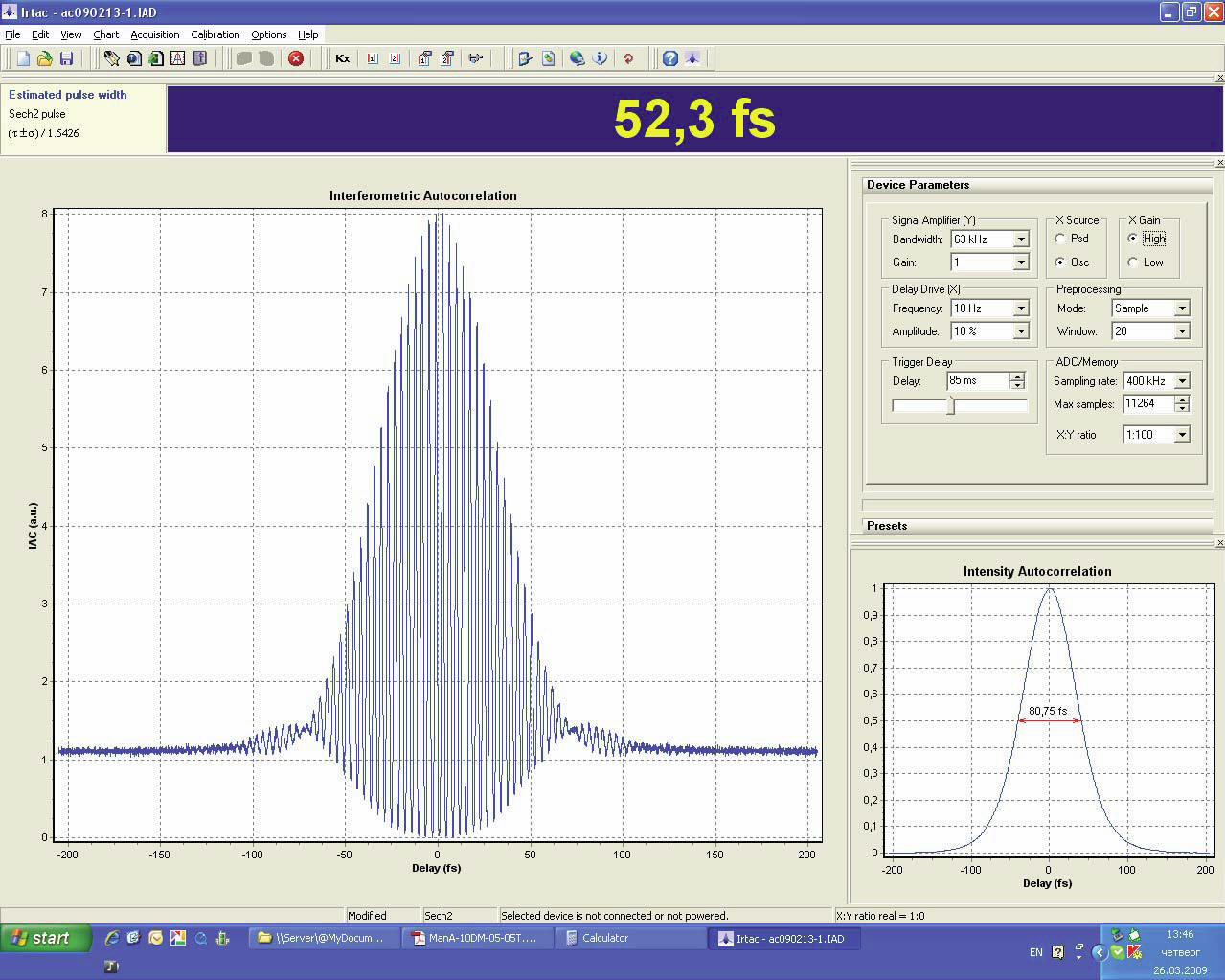
Customer:
Customer inquiry:
We need a femtosecond autocorrelator to test our pulse width. I have checked
your website and found your model Reef RT AA-10D. I am very interested in this
product. If possible, could you tell me quote of this model
Del Mar Photonics answer:
Thank you for your request at Del Mar. We can offer as follows
1) Reef-RTD real-time scanning autocorrelator
-
request a quote
Collinear (interferometric) autocorrelation
Wavelength range, nm 700-1300.
Pulse duration range, fs 20-6000
Input repetition rate 10 kHz
Sensitivity 100 mW^2
Input polarization - horizontal (if vertical please specify with order and
e-mail)
Scanning rate, Hz 0.1-20
Linear distortion, % 1%
Necessary equipment PC with USB or oscilloscope
Dimensions, mm Optical unit - 132 x 123 x 118 (195x166x130 with additional
photodetector option)
Elecronic unit - 255 x 190 x 45 - additional interchangeable photodetector units
for range extension are available (please see below)
Acquisition and analysis PC software included
2) PD-VIS Additional photodetector unit for 450-700 nm coverage
3) PD-FIR Additional photodetector unit for 1300-2000 nm coverage
Customer:
I still have another questions.
1. One key issue is whether the optical beam in collinear mode can be guided out
of optical module without passing your SHG unit and detector
head. The reason is that we want to measure pulse width on our biomedical sample
and beam is focused on our sample. Our sample also produces SHG
signals and PMT in our microscopy can detect the SHG signals. Thus, if your beam
after achieving delaying and recombining could directly illuminate
our sample, we could test the pulse width on our sample. I am not sure whether
you can realize this function.
2. Another problem is about pulse duration range (20fs-6ps). I wonder how do you
count so many peaks for 6ps in collinear operation mode.
Could you please give me a feedback Thanks a lot.
Del Mar Photonics:
1) Our autocorrelator uses two-photon conductivity in semiconductor principle
(photodetector), not SHG.
However, exactly for your application we have the
Reef-M autocorrelator.
It is able to measure pulse duration both before entry into a microscope, and at
sample position with a second external photodetector. Moreover, you can use its
internal delay mechanisms to generate delay and guide this beam without passing
the internal detector. Then you can either use our external detector in place of
your sample, or place your sample and observe SHG with your PMT. The Reef-M has
delay position (x) analog BNC output, which you might use with an oscilloscope
to reconstruct the autocorrelation trace together with intensity reading (y) of
your PMT. However, the exact routing is up to you.
2) The interferometric fringes are not counted in this case, we use intensity
autocorrelation method for pulse durations above 1 ps, as fringe structure
becomes irrelevant.
Please find enclosed the Reef-M brochure.
The price for Reef-M is
USD18,000.
Request a formal quote - Reef-M
brochure
Reef-M real-time scanning autocorrelator for microscopy -
request a quote -
pdf brochure
Collinear (interferometric) autocorrelation
Wavelength range, nm: 700-1300*
Pulse duration range, fs: 10-6000
Input repetition rate: >10 kHz
Sensitivity: <100 mW^2
Input polarization: horizontal (vertical upon request)
Scanning rate, Hz: 0.1-20
Linear distortion, %: <1%
Necessary equipment: PC with USB or oscilloscope
Photodetectors: internal and external, switchable
Dimensions, mm:
210x164x132 (opical head)
225x190x45 (electronic unit)
70x55x16.5 (external photodetector)
* - additional interchangeable photodetector units for range extension are
available
Acquisition and analysis PC software included
Price USD18,000.-

Customer:
Thank you for your reply. We are very interested in the Reef-M
autocorrelator.
However, I still have a question. First, the operation mechanism is
interferometric autocorrelation. Thus, for 5 or 6ps, how do you count so many
interferometric peaks?
Del Mar Photonics:
For pulse durations above 1 ps we use intensity autocorrelation method, where the data of interferometric autocorrelation becomes averaged, so we do not refer to fringe structure at these pulse duration values. Please refer to the attached description from our software Irtac about interferometric and intensity autocorrelation techniques with detailed explanation.
WHAT IS THE INTERFEROMETRIC AUTOCORRELATION?
Interferometric autocorrelation measurement is a technique
widely used for characterization of the ultrashort optical pulses
generated by modern mode-locked lasers. The pulse durations ranges
from several femtoseconds to a few picoseconds. The pulses may have
phase modulation and thus may be not bandwidth limited. In contrast to
intensity autocorrelation (also widely used for characterization of the
ultrashort optical pulses) the interferometric autocorrelation provides
some additional information about this phase modulation. Although this
information cannot be processed to the full time domain phase
dependence it provides a significant advice to experimenter who
develops and uses the laser systems.
Typically, interferometric autocorrelation is achieved by
splitting the optical pulse in two replicas. Each replica propagates in
different optical path, and the paths difference is controlled by a special
translation unit with the generator and the position measurement system
(the scanning unit). Finally, two replicas of the source pulse with the
relative delay varying in the time are combined in the single collinear
beam and passed to nonlinear converter. This could be SHG, or twophoton
absorption measurement, or something else depending on
particular device construction. Thus the signal from photodetector is
proportional to the square of the sum of replicas intensities. Combining
the signals from scanning unit as time delay (or as X-coordinate), and
from photodetector as amplitude (or as Y-coordinate) one obtains the
interferometric autocorrelation of an investigated laser pulses.

Del Mar Photonics, Inc.
4119 Twilight Ridge
San Diego, CA 92130
tel: (858) 876-3133
fax: (858) 630-2376
Skype: delmarphotonics
sales@dmphotonics.com
www.twitter.com/TiSapphire